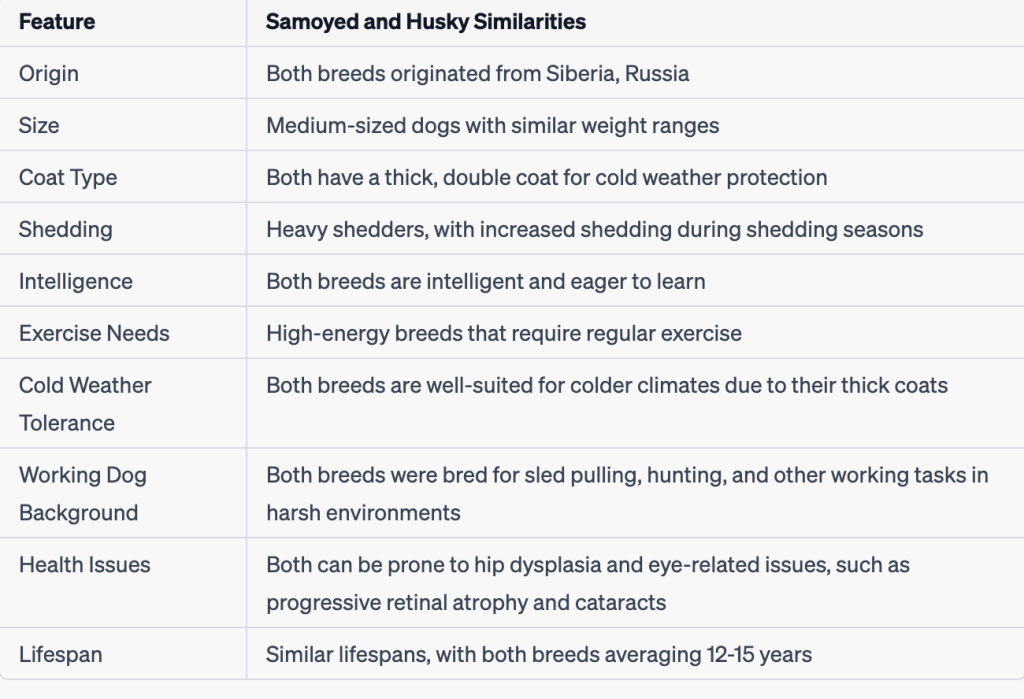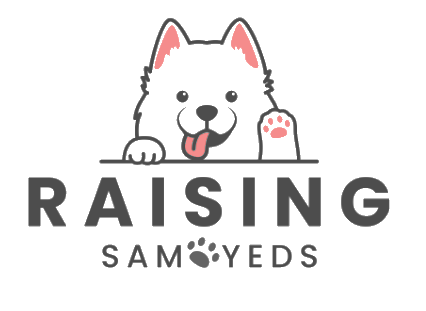Samoyed vs. Husky! Both are two wonderful working dog breeds that have won over many dog enthusiasts across the globe. Both breeds share similar features – thick coats, striking eyes, unmistakable sled dog heritage – but there are key differences that set them apart.
In this article, we compare Samoyeds with Huskies by providing insight into their histories, appearances, temperaments, exercise needs, trainability requirements, grooming needs requirements, health issues as well as living environments – so potential owners can select their ideal match!
This comprehensive comparison should help potential owners decide on which breed may suit their lifestyle and preferences best!
Samoyed vs. Husky Table On Differences

Samoyed vs. Husky Table on Similarities

Comparison Between Samoyed and Husky
History and Origin
Samoyeds
Samoyeds originated in Siberia, Russia where they were bred by indigenous Samoyedic people. These versatile working dogs were originally used for herding reindeer and hunting games as well as pulling sleds in harsh, native environments – making Samoyeds invaluable companions!
Huskies
Similarly, Huskies can also be found in Siberia, Russia, and were originally bred for use as sled dogs by Chukchi people for use on sleds. Huskies were specifically developed with fast speed, strength, endurance, and hardiness needed for working tirelessly in harsh Siberian conditions. P. A. E. W.:
Physical Appearance
Samoyeds
Samoyeds are medium-sized dogs, with males typically weighing 45-65 pounds and females 35-50. Samoyeds can be distinguished from other breeds by their distinctive all-white, cream, or biscuit coat, which helps protect them against cold temperatures. Furthermore, these breeds are notable for their “smiling” facial expressions due to upturned corners of their mouths that prevent drooling that could otherwise form into icicles in subfreezing temperatures.
Huskies
In comparison with Samoyeds, Huskies tend to be slightly larger dogs, with males typically weighing 45-60 pounds and females 35-50. Huskies come with different coat colors and patterns, such as black-and-white stripes or stripes of different hues (red-and-white is particularly popular), including black-and-white spots or solid white, gray and white, or pure white coats; their eyes may feature blue, brown, or even one of each color (known as heterochromia) while their eyes often exhibit more intense gaze than their counterparts do compare with Samoyeds.
Temperament and Personality
Samoyeds
Samoyeds are beloved family pets that thrive off being around people and thrive from attention and social interaction. Affectionate with family members and children alike, these smart canines make excellent companion. Samoyeds enjoy the company of humans, making them ideal family companions.
Huskies
Huskies mes Huskies are friendly dogs but tend to be more independent than Samoyeds. With high energy and playful dispositions, Huskies make the ideal pet for active families; however, due to their escape artist proclivities (they are known for escaping fenced yards or breaking loose from leashes), it’s essential that potential Husky owners provide secure environments for their pups.
Exercise and Activity Levels
Huskies and Samoyeds, which are both high-energy breeds, require daily exercise in order to remain happy and healthy. Samoyeds require physical and mental stimulation through daily walks, playtime, or training sessions in order to burn off energy efficiently and prevent boredom or destructive behavior from setting in.
Huskies need more vigorous daily exercise due to their working dog background. Jogging, hiking, and participating in dog sports such as agility or skijoring are excellent ways for Huskies to release energy, and an active Husky is more likely to make for an ideal companion. Trained Huskies offer numerous trainable behaviors.
Trainability
Samoyeds
Samoyeds can be intelligent dogs but, at times, can also be stubborn, which makes training them challenging. Consistency, patience, and positive reinforcement are essential when working with this breed; setting yourself as the leader early is also key in making sure they respect your commands and don’t boredom set in. By offering mental stimulation through puzzle toys or obedience training activities, you can help keep their mind busy while keeping boredom away.
Huskies
Huskies can be eager learners yet are strong-willed enough to challenge authority when training is needed. Establishing a firm, consistent leadership role with positive reinforcement techniques during training is vital. Huskies may become bored easily with repetitive tasks; keeping training sessions interesting and varied is therefore necessary.
Grooming and Shedding
Samoyeds
Samoyeds have thick double coats that require daily brushing to prevent matting and maintain their health. Daily brushing should also help reduce any loose hair around your home and maintain their coat in good condition.
Huskies
Huskies also possess thick double coats but typically require less grooming compared to Samoyeds. Weekly brushing should keep their coat healthy; more frequent brushing may be required during shedding seasons or other times when excessive hair needs removing from the house. Both breeds are known for being heavy shedders, so potential owners should expect regular grooming sessions and the possibility of hair accumulation around the home.
Health and Lifespan
Samoyeds
Samoyeds tend to be generally healthy dogs but can occasionally experience health problems like hip dysplasia, progressive retinal atrophy, and diabetes. Regular vet check-ups, diet management, and proper exercise can all help manage and prevent these issues; on average, Samoyeds live 12-14 years.
Huskies
Huskies tend to be healthy dogs but are susceptible to hip dysplasia, cataracts, and progressive retinal atrophy – similar to Samoyeds. Regular vet visits, diet, and exercise can all help ensure optimal health; Huskies typically live 12-15 years.
Living Environment
Samoyeds
Samoyeds are versatile dogs that thrive in various living situations, from apartments to large homes with yards. Due to their thick coats, Samoyeds typically do best in cooler climates; those living in warmer areas should provide shade and water sources in order to prevent overheating. To ensure they don’t experience separation anxiety issues when away for extended periods.
Huskies
Huskies require plenty of space to roam and play, making them better suited to homes with larger yards than Samoyeds. Like Samoyeds, Huskies prefer cooler climates and are less likely to experience separation anxiety compared to their counterparts; therefore, they may make an ideal companion choice for people who work long hours or frequently leave home.
Samoyed vs. Husky Conclusion
While Samoyeds and Huskies share many similarities, key distinctions set them apart. Samoyeds tend to be friendly, social, and affectionate family pets, while Huskies prefer active households. Furthermore, each breed varies significantly when it comes to exercise needs, trainability requirements, grooming needs, health concerns, and living environments. So the choice between Samoyed or Husky ultimately depends on your unique lifestyle preferences.
Frequently Asked Questions
What are the main differences Between Samoyeds and Huskies?
Answer: Samoyeds and Huskies differ significantly when it comes to physical appearance, temperament, trainability, grooming requirements, living environment preferences, social behavior, and affection levels; Huskies tend to be more independent. Samoyeds often have more prominent “smiling” facial expressions, while they usually come with lighter coat colors than huskies; both breeds offer an array of coat colors and patterns to choose from.
Are Samoyeds or Huskies better suited for families with young children?
Answer: Samoyeds and Huskies can make great family pets due to their social nature and affectionate disposition; however, children must learn how to interact with any dog safely and respectfully, irrespective of breed.
Which breed of dog is easier to train: Samoyed or Husky?
Answer: Samoyeds and Huskies can be difficult to train due to their intelligence and independence, yet both breeds can be successfully trained with consistency, patience, and positive reinforcement. Training sessions must remain engaging while setting an early leadership role.
Do Samoyeds and Huskies get along well with other pets?
Answer: Samoyeds and Huskies usually get along well with other pets when introduced and socialized from an early age. However, Huskies tend to possess higher prey drives which might make them unsuitable for households with smaller animals such as cats or rabbits.
Are Samoyeds and Huskies suitable for first-time dog owners?
Answer: Samoyeds and Huskies can make great starter pets for first-time dog owners, though they require proper training, exercise, grooming, and an understanding of their breed’s unique characteristics and needs. Newcomers to owning or training pets may benefit from seeking guidance from experienced breed owners or trainers for an enjoyable and successful experience.
